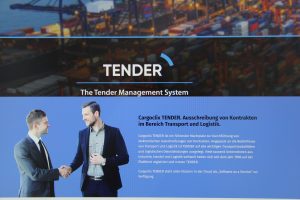transport logistic: New Cargoclix TENDER platform optimises the tendering process

Cargoclix TENDER: With a revised platform, the software provider comes to transport logistic
Cargoclix at transport logistic: Hall A3, Booth 315/416
- TENDER scores above all with high performance and intuitive operation.
- Cargoclix and TIMOCOM cooperate immediately and set new industry standard for SLOT time window management system.
(Freiburg i.Br., 2.5.2019) The software provider Cargoclix has fundamentally revised its well-known tender platform TENDER. The IT experts present the improved, modern marketplace for tendering transport and logistics service contracts at the transport logistic trade fair in Munich from June 4th to June 7th. At their stand (Hall A3, Stand 315/416), the Breisgau-based company will also be presenting innovative functions of the SLOT timeslot management system.
TENDER’s history spans two decades since its launch in 1999. The cloud-based software can be used to process worldwide tenders for contracts for transports by road, rail, air freight, sea and inland waterway transport, courier-express parcel services and logistics services. “With more than 28,000 registered members from industry, trade and forwarding, TENDER has developed very well and is one of the leading international tender platforms. The users appreciate above all the high creative leeway of the powerful system. Now we revised the platform intensively and adapted to the new habits of the users. Our pilot customers were amazed at how quickly even very large and complex bid matrices can be entered and processed in the system”, reports Prof. Dr. Victor Meier, consulting partner of Cargoclix. Users benefit not only from increased performance, but also from ease of use, so that even large tenders can be carried out in much less time.
Cargoclix offers TENDER users a flexible and cost-effective pricing model. “The great strength of TENDER is its user-friendly and intuitive operation as well as its high flexibility. We are thus setting new standards,” predicts the Cargoclix founder.
The IT specialist also has its SLOT timeslot management system for optimising processes at the ramp in its luggage for the fair. More than 50,000 registered members now work with the tool, which is one of the most frequently used timeslot management systems. Experts from Cargoclix will also be explaining the advantages of the additional modules Cargoclix TERMINAL (self-check-in by the driver) and the KPI tool Cargoclix MONITOR (control of the ramps using individual KPIs) at the four-day trade fair.
The additional module Cargoclix ETA (Estimated Time of Arrival) makes it possible to calculate a precise forecast of a truck’s arrival time and display it directly in SLOT. The vehicle’s GPS data is released to Cargoclix for tracking and sharing via an app or interface from the truck’s telematics system. The partner PTV from Karlsruhe is responsible for calculating the ETA and the partner Agheera from Troisdorf for transmitting the GPS data from the telematics system. Brand new is the possibility to transfer the telematics data for the ETA forecast directly via interface via TIMOCOM. By combining the telematics data of the TIMOCOM users and SLOT, the two IT companies want to solve the time-consuming congestion problem in incoming and outgoing goods and set a new industry standard.
The timeslot management SLOT and the GPS data of the users of TIMOCOM enable a flexible ramp management. By continuously comparing position data with the booked delivery time window, companies from industry and commerce can precisely calculate the ETA and check whether the truck will reach the ramp on time or whether another supplier can be brought forward.
In practice, the transport service provider releases its GPS data for a limited period of time. These are used to regularly determine the forecast arrival time and display it to the ramp operator in SLOT. In this way, the ramp operator can calculate and plan with real-time data. This accurate time forecast shortens the waiting times of truck drivers or, ideally, cancels them out completely.
“Due to the growth in road freight transport, many fear that the ramp problem will worsen. But waiting times at the ramp no longer have to be a problem. By integrating dynamic data, processes can be made much more efficient and flexible for ramp operators and transporters. No waiting time, even in the event of delays or traffic jams, that is above all a question of technology,” emphasises Meier. In the cooperation with TIMOCOM, the data sovereignty remains untouched, since the bits & bytes are only called up for ETA calculation.


Follow Us on Social Media